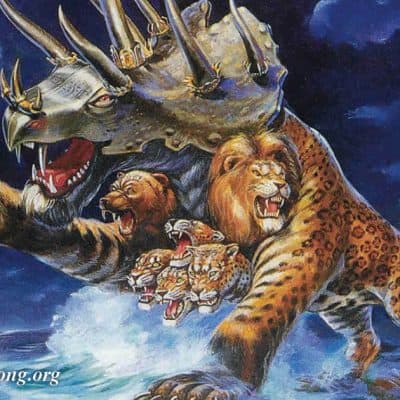(How Ferdie, the Phantom Fungus, Foils Evolution!)
Evolutionists hate questions such as “Which came first, the chicken, or the egg?” Symbiosis is another subject they hate. For, if all life gradually evolved from simple to complex, how can they explain TWO life forms, living together, in a “symbiotic relationship”; each one unable to survive without the other? Here is a humorous look at how Ferdie the phantom fungus fouls up evolutionists!
What if you had a painting over your fireplace, or on the wall in your living room, picturing a shapeless blob—an amoeba? If you were an evolutionist, when visitors asked about the blob, you could say, proudly, “Oh, that’s a distant ancestor of mine!”
Did you and I come from lovesick amoeba? Did your intelligent mind gradually evolve from single-celled animals into sponges and sea anemones? Did your more recent ancestors shed their fins and gills, climb ashore, and begin dragging their knuckles along the ground as they searched for food?
For if evolution is to be believed, just such a scenario took place! “In the beginning,” say evolutionists, “was the hydrogen atom.” So gargantuan was this one atom that it represented all the matter in the universe! Then, one day, it EXPLODED! Hurtling out in all directions away from this “big bang” were countless billions upon billions of portions of that one gigantic atom. These jagged, shapeless pieces of the atom gradually assumed round shapes. Some became huge stars. Others became planets.
Astonishing? Yes. And as untrue as any of Grimms Fairy Tales.
But, believe it or not, the “big bang” theory is the most commonly accepted explanation for the origin of the universe, the solar system, and our earth with all life upon it. By no means will God-defying evolutionists accept the language of Genesis, “In the beginning, God created…”
But the existence of God can be proved, while evolution remains only an empty theory. David said “Only the fool hath said in his heart, There is no God!” This world is filled with educated fools.
One would think those who are most qualified to know about God are those who make a career out of science; the physical sciences especially, such as biology, mineralogy, geology, paleontology and the like. Speaking of the educated fools of his day; the pagan Greek and Roman philosophers, Paul wrote, “For the wrath of God is revealed from heaven against all ungodliness and unrighteousness of men, who hold [Greek: kataballo, meaning, hold back: “suppress”] the truth in unrighteousness;
“Because that which may be known of God is manifest in them; for God hath showed it unto them.
“For the invisible things of him from the creation of the world are clearly seen [by observing the physical properties of matter; by looking at all life forms on earth], being understood by the things that are made, even his eternal power and Godhead; so that they are without excuse:
“Because that, when they knew God, they glorified him not as God, neither were thankful; but became vain in their imaginations, and their foolish heart was darkened.
“Professing themselves to be wise, they became fools,
“And changed the glory of the uncorruptible God into an image made like to corruptible man, and to birds, and four-footed beasts, and creeping things.
“Wherefore God also gave them up to uncleanness through the lusts of their own hearts, to dishonour their own bodies between themselves [many were homosexuals]:
“Who changed the truth of God into a lie, and worshipped and served the creature more than the Creator, who is blessed for ever. Amen” (Romans 1:18-25).
Pagan philosophers fancied themselves extremely intelligent, erudite. In the vanity of their darkened minds, they preened themselves about their “knowledge.” Yet, they rejected revealed knowledge, as well as simple logic, and, building elaborate hypotheses about the origin of things and the nature of man, wandered far afield from what their own eyes should have told them. That is this: Law requires a Lawgiver. Life requires a Life Source; a Lifegiver. Design and symmetry require a Designer. The operation of all laws require a Sustainer. They should have known that life is sustained by life, and that life comes only from preexisting life of the same kind!
Of course, fulfilled prophecy and answered prayer are positive proofs of God, but no agnostic or evolutionist would ever admit the truth about these two major subjects.
Symbiosis — Two Life Forms Living Together
You and I could not live without the flowering plants. Which came first, animals or plants? Animals breathe oxygen produced by plants and diatoms in the sea. Plants absorb carbon dioxide given off by man and animals as they extract oxygen from the air, and breathe out carbon dioxide.
You and I could not live without the helpful bacteria in our bodies. Which came first, the bacteria, which cannot live apart from our bodies, or our human bodies?
Flowering fruit and nut trees cannot live without bees and insects to pollinate them. Which came first, the plants, or the bees?
Throughout all nature, there are countless examples of symbiosis—two completely different life forms, each one contributing to the survival of the other. Obviously, they HAD to come into existence at the same time! Yet, this is utterly devastating to the theory of evolution! Now, let’s investigate an outstanding example of symbiosis, which PROVES the existence of a divine, all-powerful Creator God!
The Humble Lichen — Is It Really Simple?
A few years ago, I had climbed to above timber line in Colorado’s Sangre de Cristo range above the San Luis Valley. Here, at above 12,500 feet, the air was too thin for trees to survive. Yet, in a kaleidoscope of fabulous color; rusts, reds, ochers, umbers, greens, whites, blacks, were many varieties of lichens, clinging to virtually every rock in sight.
Such elevations are extremely inhospitable to man. In only a few cases, such as the fabled Incas of the Andes and the Nepalese in the Himalayas are humans and animals found at such elevations. Yet, everywhere I looked vivid, colorful life abounded—lichens.
Lichens are probably the hardiest plants in the world. They thrive in the highest elevations, and in the coldest climes. They can exist where no other kind of life can exist; even three hundred feet under the surface of the ocean. What kind of nutrition can be found on a rock? Do they “eat” the rock? They are seen clinging to tree bark, decaying wood, rocks; on the soil, or even growing on each other.
Evolutionists seem to think lichens are “simple.” Therefore, they have dubbed these plants as the “lowliest” of all the plants. One late scientist even called them “poor trash of the plant kingdom.” A lichely story! But the gentleman who disdained lichens has long since returned to the soil from which he came, to eventually be resurrected into the great judgement of God, when he will learn with astonishment that his rejection of God was utterly foolish. As a ploy of evolution, many of the most puzzling and complex forms of life are called “simple,” and therefore dismissed, as unworthy of the layman’s notice; unworthy of serious consideration.
The reason evolutionists attempt to dismiss the lichen with such harsh words is because lichens present an insurmountable problem for evolution. They are an outstanding example of symbiosis; of two different kinds of plants living together; neither capable of surviving without the other.
Lichens — Incredibly Complex!
Look up lichens in your encyclopedia. Here is what it will tell you: “LICHEN, a plant developed [sic] through the effect on each other of two entirely different kinds of plant that grow together to make a single organism. Each participant belongs to a different order of the plant kingdom. One is a fungus, a type of mushroom or mold; the other is an alga, in this case a microscopic single green cell…” The name of the alga most commonly found in lichens is Protococcus from Greek protos, meaning “first,” and kokkos, meaning “seed.”
Later, the encyclopedia admits, “The unique place of lichen in the plant kingdom relies, not upon the interdependence of two kinds of plant—which is common, for example in parasites—but upon the way in which the two plants stimulate each other so that together they form a third type of plant unlike either of the two originators. The lichen has its own peculiar structure, its own life and ways of growing and reproducing. Such a merging of two kinds of plant to conjure up a third kind that will reproduce true to kind is a biological anomaly” (Encyclopedia Americana, Vol. 17, p. 360, emphasis mine).
An “anomaly” is something which is “out of place.” Something which doesn’t belong! The dictionary says: “ANOMALY: departure from the rule; irregularity.” Evolutionists continually come across these “anomalies”; things in nature which are supposedly not normal. Actually, evolutionists might as well say ALL NATURE IS AN ANOMALY, since nature is FILLED with countless thousands of contradictions to their empty theory that life came from the not living!
Their so-called geologic succession of strata represents billions upon billions of tons of anomalies, since their entire catalogue of a so-called orderly succession of strata is shot through with errors (If you have not yet read my brochure entitled “The BIG LIE of Evolutionists and Agnostics,” which investigates the so-called “Geologic Succession of Strata,” please call or write for your free copy).
Is a lichen really something apart from the normal? Not at all—except when it defies the theory of evolution.
Lichens, and hundreds upon hundreds of life forms, including humans, animals, fish, insects, and plants are living together in symbiosis. Therefore, symbiosis is found normally throughout the creation. However, when the befuddled minds of stubborn evolutionists encounter the impossible task of explaining how these symbiotic relationships could have evolved they speak of them as “trash” and claim they are an “anomaly.” What arrogance! What educated stupidity! In a debate, it is obvious when one begins to personally attack his opponent that he has lost the argument. One would think an evolutionist would be embarrassed to put his name to such ridiculous statements as calling one of God’s intricate creations “poor trash,” but they do so in order to dispose of an otherwise nettlesome problem for their empty theory!
Now, think! How could these two completely different kinds of living things have linked up? How could one have survived without the other? How could one have come into being without the other? How could they then begin to reproduce a completely different, third kind of plant which breeds true to kind?
Because they have no real answers for such questions, evolutionists call lichens “radical!” Listen:
“Their radical evolutionary innovation—the employment of living algae to furnish them with the primary products of photosynthesis—has nonetheless enabled them to infiltrate ecological niches on earth where nothing else can survive” (Makenzie Lamb, writing for Scientific American. Emphasis mine).
Fantastic. So these so-called “poor trash” plants are capable of radical innovation. Not only that, but they were able to somehow reason, plan, and bring into being a process to furnish themselves with the necessary means of survival! Then, deviously, they were able, like so many little fifth column agents, to “infiltrate ecological niches…where nothing else can survive.”
Which are they, “poor trash,” or “planning, thinking, scheming, radical innovators”? Of course, to get rid of the problem, evolutionists simply call them “anomalies,” and move on to the next subject like politicians and preachers are prone to do when questioned closely about the doctrines and political issues. When you can’t explain something, either ignore it, ridicule it, or simply change the subject. If you are dishonest, that is.
One of the primary forces supposedly guiding evolution is the required adaptability of thousands upon thousands of species of plant and animal life so as to survive. The “survival of the fittest” is what it is all about.
Notice carefully what this evolutionist author said. The lichens were able to innovate. That means to do something new, and unusual; a departure from the norm. They have been able to employ living algae to furnish themselves with the primary products of photosynthesis.
That means they were able to “utilize, manipulate, hire, use, gain by, exploit,” living algae. Wow! Sounds more like a clever lawyer plunging into the stock market, or cranking up a company! But a dumb, simple, piece of trash did all this? Just HOW did lichens do all this?
I can step outside my home here in East Texas, and observe several kinds of grey, rust, reddish and yellow lichens clinging to the bark of many kinds of hardwoods; hackberry, hickory, oak and elm trees. Here, the elevation is a mere 460 feet above sea level.
So why did lichens need to sneakily creep into “ecological niches” where nothing else can survive? The answer is, they didn’t. They were created at creation, and appeared on trees and rocks just before Adam and Eve walked the earth. But returning to our flight of fancy with evolutionary thought, since there are billions of lichens all over the forests at very low elevations, why did they need to develop such a complex system of life so as to creep into a harsh, barren, bitterly cold, wind-swept, lifeless environment like the Brooks Range in Alaska, or well above timberline in Colorado, or the Hindu Kush, or the Pamir Knot?
Why migrate to the sea, and gradually creep ever deeper, until they are found deeper down than any other kind of plant life? What power, or force, or stimulus, caused all this? Obviously, they didn’t need to sneakily “infiltrate” these ecological niches at all, for they are surviving quite well at 460 feet!
But remember! Evolution is based upon the “survival of the fittest!” The only driving force which could have caused lichens to show up in such amazingly different habitats, according to evolution, is that they could not have survived unless they did!
But wait! Since they are found from the very highest mountains to the depths of the sea, it becomes obvious this whole premise; the “infiltration of ecological niches” as the evolutionist put it, is PROOF THE THEORY IS RIDICULOUS!
But notwithstanding plain logic, let’s try to use our imaginations. After all, that is what evolutionists do all the time!
Let your mind wander back—back—far, far back—no, much further back! Back into the dimmest reaches of time when there were no lichens as yet. Let us now focus our attention on an ancient forest floor (forgetting, for the moment, how the trees, shrubs, grasses and flowers got there, or where the sun and moon came from, or what causes gravity, or where water came from, or photosynthesis, or the animals walking about under the trees, or, or, or…).
Suddenly, under our powerful, imaginary microscope, we see Ferdie the fungus, furtively floating like a phantom! He is a tiny free-floating fungus spore. He is hanging suspended in the air. We don’t know where he came from, for there are no other fungi in the whole world as yet [remember! He had to come from SOMEWHERE, for there had to be a very FIRST fungus!], but there he is. What is he, we wonder? Looking closely, we think he may resemble the spores (which do not yet exist) from a mushroom. But there are no mushrooms, yet. Fungi is the Latin word for “mushroom.” Next time you go to an Italian restaurant, you might notice some of Ferdie’s offspring offered with your food. You see, it makes scientists sound much more intelligent to use Latin, and Greek, than English. Besides, “mushroom” is a bit confusing. What does it mean? A room filled with mush? Or a room where one eats corn meal mush? So they use Latin, or Greek.
We find that there are many, many kinds of fungi, which are slime-like, algae-like, watery, like mildew, blue and green molds, powdery mildews, spherical fungi, cup and club fungi, and many others.
Little did phantom Ferdie the free-floating fungus know that he would “evolve” from an original free-floating fungus into a whole new world of incredible organisms that help break down and decay dead organic matter (and therefore could not have survived unless there was dead organic matter about before they “evolved”). Little did Ferdie realize that some of his less desirable offspring would become parasiticfungi, which can blight crops and trees, and become a disastrous disease, costing countless dollars to agriculture! Had he known this, he might well have drifted in the air until, running out of whatever it was he was feeding upon, he starved to death, or, failing to find a comfortable mate (we’re coming to this) simply fell on a hard piece of granite and died.
But forgetting for the moment all his future difficulties, let’s get back to Ferdie, our furtive, free-loading, free-floating, phantom fungus of the forest. (Can’t you just hear the little animals saying, “Oh no! There is a fungus among us”?).
Somehow, though he has no brain, Ferdie knows he must find an alga and link up with it (or her, perhaps?), or he cannot survive. A chance puff of wind carries his microscopic little body directly into the clutches of the only alga to ever have evolved, which just “happens” to be in the immediate vicinity. Think of it! A tiny, microscopic alga—the ONLY ONE IN THE UNIVERSE—had to “evolve” SEPARATELY, in order to link up with Ferdie!
But the alga could not have survived separately! Notwithstanding this impossible difficulty; notwithstanding the possibility that the little alga COULD have popped into existence 8 or 9,000 miles away, perhaps in the Atlas Mountains in Africa, THERE SHE WAS!
Thankfully, they both evolved together, suddenly, and within a few feet or yards of each other! Wow! Isn’t evolution wonderful? The incredible planning of evolution; the designof evolution; the carefully thought-out, intricately developed creative ability of “evolution” is mind-boggling, indeed, isn’t it? Of course, when one worships “nature,” always called “mother” instead of “father,” and endows blind chance with all this power and design, one does not need to worry about any God or His laws which regulate all life—much less worry about the punishments for sin.
But back to our fanciful story–er–our scientific investigation of Ferdie’s fanciful flight to find his future friend and fellow-survivor, Alice, the alga!
Immediately, the little alga we shall call “Alice,” clutches the phantom fungus Ferdie to her green, ugly body, and the two begin (blush!) happily surviving together.
What luck! think of the billions of years it must have taken for Ferdie to evolve in the first place—to become the very first fungus spore! Then think of the difficulty for Alice the alga to have evolved separately, and to have done so not just within a few million years, or even ten years, but on the same afternoon the thermals in the forest bore little Ferdie to her bosom! Instantly, the two became twitterpated.
One would think the opposite. One would assume Alice would say, “Ugh! An ugly spore, and he’s looking at me!” Then, she would attempt to slowly creep away. One would think Ferdie would say, “Ugh! An ugly piece of green, slimy, something or other. No way she’s getting her clutches on me!” and stay airborne for another few hours, looking for some other alga to help him survive. But there weren’t any other algae about! They hadn’t evolved yet.
But no, evolution requires that it was love at first sight—er, clutch.
Soon, tiny, coral-like growths called “isidia” begin growing around the rim of the “fruiting body” which is what Phantom Ferdie the fungus and Alice the alga have formed. Each little bud which breaks off is a complete lichen, composed of both fungus and alga, and capable of reproduction after their own kind. Wow! What a major miracle Ferdie and Alice have wrought. Neither could have come into existence without the other. But, suddenly, there they were! And their very first attempt was successful! They produced little Alfred, and little Ferdie, Junior. Except they had to name them Alfreda and Alferda, because each were created possessing both sexes! What a problem for evolution! No wonder they would like students who read their text books to dismiss lichens as “poor trash” and “anomalies,” and go on to something more interesting, like how dolphins and whales used to be four-footed quadrupeds who could climb trees. (Really! — this is what evolutionists say!).
You see, a lichen is composed of a fungus and an alga. Each of these microscopic, living organisms live in close association with each other. The special kind of lichen fungi never live alone, like other fungi do. They can only live in close association with lichens. The alga and the fungus contribute to the welfare of each other by storing water, sending “roots” down into the porous holes in rocks, or into tree bark, producing food through photosynthesis, and by “feeding” upon the decaying organic material.
Oops! Another terrible problem for evolutionists! Lichen fungi, like Ferdie, have no means of photosynthesis and would quickly die unless they were linked with an alga. Good old Ferdie. He found Alice just in time, or there would not be a single lichen about!
Talk about “Alice in wonderland!” Alice the alga—the very first, one of her kind, never before, suddenly “evolved” (suddenly? This is anathema to evolution!), in just the right place, at just the right time, to find, not her prince charming, such as another alga, but this time an ugly, misshapen, “spore” floating around in the breeze! But notwithstanding these insurmountable difficulties, IT HAPPENED! (Well, not really, but for evolution to be true, something like this HAD to happen!).
Alice does all the work. The cells in her body manufactures food for both of them, since Ferdie is incapable of it. But Ferdie does his part too, for he provides the incredibly complex structure which binds both of them together, and serves as a storage tank for water and fat, so that Ferdie and Alice can survive together during the dry season.
Of course, the very first time Ferdie found Alice (neither of whom could have previously existed—so they didn’t exist—so there wasn’t any possibility of lichens “evolving,” so lichens don’t exist, today. But they do, so…), neither of them knew anything about any approaching “dry season.” Furthermore, they had never had time to reason out and plan for the sneaky maneuver to “infiltrate” the frozen tundra to the North. After all, just how many trillions of generations of lichens did there have to be to drop little “buds” and “fruiting bodies” beside themselves, or to be carried by a chance gust of wind from a temperate zone forest to the Brooks Range or across the Atlantic, down the length of the Mediterranean, across the Mideast, and into Nepal and the Himalayas?
So, when the very first dry season came along, foolish phantom, formerly-free-floating Ferdie, now “married” to ugly Alice, not knowing he should have stored all that water and fat, was happily munching on the food Alice gave him. Along came the dry, hot summer, and they dried up and died. So there are no lichens around today. But there are. Therefore, the very first time either came into existence, they had to somehow “know” (without having any brains) how to store up against the dry season together.
Look closely at Ferdie and Alice, as they exist, we assume happily, together. There is an “apothecium,” or “fruiting body” on the surface of the lichen. Without invading their privacy, or delving too deeply into just HOW this is done, suffice it to say Ferdie and Alice are producing tiny, microscopic spores as a result of their chance encounter. They are so light in weight that they hang suspended above the fruiting body in the air; borne aloft by the tiniest changes in temperature, which causes hot air to rise from the forest floor.
How did they get into the air? Well, somehow, Ferdie and Alice “evolved” this cup-shaped “fruiting body,” which forcibly ejects the spores into the air. What luck! What good fortune! All about them are deer and elk, forcibly ejecting various substances onto the ground. Why didn’t Ferdie and Alice simply drop their spores beneath them? Perchance they did, for the first few millions or billions of years. But as they did, the spores, incapable of putting down roots, simply died. But there couldn’t have been any spores, because Ferdie and Alice had already died, millions of years earlier! But, somehow, the very first time a fungus and an alga came together in marital bliss, they joyfully ejected their little spores into the air.
Chance gusts of wind carry them about. Some are carried here and there on the fur of animals (where did they come from?) or birds’ feet (same question).
The trouble is, we encounter a myriad different types, sizes, shapes and colors of lichens as we look at the forest floor. Some of them have rows and rows of fruiting bodies. Others have large, saucer-shaped fruiting bodies which ooze slime, instead of eject spores (Alice the alga should counsider herself fortunate—what if she had evolved into a piece of slime, and met “Slippery Simon, the sticky, slick, slithering slime”?). They are black, grey, brown, rust, yellow, orange, ochre, green, bluish, red, and white, and every shade in between.
Then, as the spores are carried about, or as they drop off, or ooze out, they must encounter some algae cells of precisely the correct kind, or they cannot reproduce.
Therefore, evolutionists would tell us, they must have “evolved” at the same time—together. But evolution requires billions and billions of years. Ejecting spores into the air takes place in only a few seconds! Oozing slime is to no avail, unless the slime, with its spores, comes into contact with the exact kind of algae needed to reproduce. Since the algae of this kind cannot reproduce without the slime from the correct kind of lichen, and the lichen slime cannot reproduce without encountering the correct kind of algae, which came first, Slippery Simon the slime, or Ferdie the Phantom Fungus and Alice the Alga?
What if the algae “evolved” in Siberia, but the lichen which oozes slime “evolved” in Montana? Problem! Neither could have survived. So they don’t exist today. But they do. Therefore, they had to come into existence, in myriad numbers, all over the world at the same precise moment in time!
Lichenologists are not sure how some of them reproduce at all. Some reproduce tiny pieces of lichen, while others produce spores which must unite with algae. Says one authority, “The role that spores play in the propagation of lichens is completely unknown, for no one has ever followed the development of a lichen thallus from a germinated fungal spore…We must admit that the most significant aspect of lichens, their reproduction, is still a mystery” (LICHEN HANDBOOK, A Guide To The Lichens Of Eastern North America, by Mason Hale).
It is at least as much a mystery how anyone who studies lichens can avoid throwing up his hands in despair and admitting, “You know, I think there might be a Creator God who did all this, after all!”
Ferdie and Alice were not only sneakily capable of “infiltrating” the frozen North, but were capable of reproducing, not only after their own kind, but dozens of incredibly complex, intricate lichens and fungi—multiple trillions and quintillions of offspring, and not a clue as to how they could have evolved, when neither could have survived without the other!
Furthermore, they are found from thousands of feet above sea level to three hundred feet beneath the surface of the ocean; the deepest kind of plant life known to exist! How? Why do this? Was it necessary to survive? Did they “migrate” to the depths of the oceans, and to the heights of the Rocky Mountains?
Even a slug can travel faster than a lichen, clinging to a rock. Isn’t it all incredible? Evolutionists are like wide-eyed children, sitting in front of a Disney cartoon, assuming all they see is true; that deer talk, and ducks wear only a jacket, but no trousers! They are like fascinated day-dreamers, conjuring up the weirdest fiction, and attempting to pass it on as fact.
Truly, only the fool hath said in his heart, “There is no God!”
Symbiosis is proof of a law in motion; an immutable, immovable absolute which governs many creatures in our environment, including man. Life is only possible because other life forms exist. You and I could not live without eating living plants and various kinds of fish and animal flesh. We could not digest our food, and it could not be carried into our bloodstream to feed our heart, liver, lungs and brain, without our miraculous bloodstream, with its dizzying array of blood cells and chemical compounds which make life possible.
Symbiosis is a PROOF OF GOD! It is absolute proof that life was CREATED AT ONCE; that it had an instantaneous BEGINNING! Whether clown fish and deadly sea anemones which live in symbiotic harmony, or Ferdie and Alice, happily producing spores, all symbiotic life forms prove the existence of an all-wise, all-powerful Creator God!
All about you is LIFE. Microscopic life, and living things which support life! You and I could not live without foods which come from the ground. Those foods could not grow without the bacteria which cause decay, producing rich soil. All life forms complement each other. Nothing lives or dies to itself. A tree falls in the forest, to decompose, and produce fertile soil for its offspring nearby. Your own body is host to many, many forms of life, including little yeast spores, which float about in the air.
If you could, at this moment, take a tiny piece of clean, clear glass, and touch it to your nose, then place it under a powerful microscope, you could identify these little yeast spores, clinging to the oils on your skin. And, who knows? Maybe one of Ferdie and Alice’s little offspring would be smiling up at you, hoping you would drop them off on the nearest decaying log!
You may copy and distribute this information only to friends and family without changes, without charge and with full credit given to the author and publisher. You may not publish it for general audiences.
This publication is intended to be used as a personal study tool. Please know it is not wise to take any man’s word for anything, so prove all things for yourself from the pages of your own Bible.
The activities of the Garner Ted Armstrong Evangelistic Association are paid for by tithes, offerings and donations freely given by Christians and co-workers who are dedicated to preaching the gospel according to Jesus Christ.










